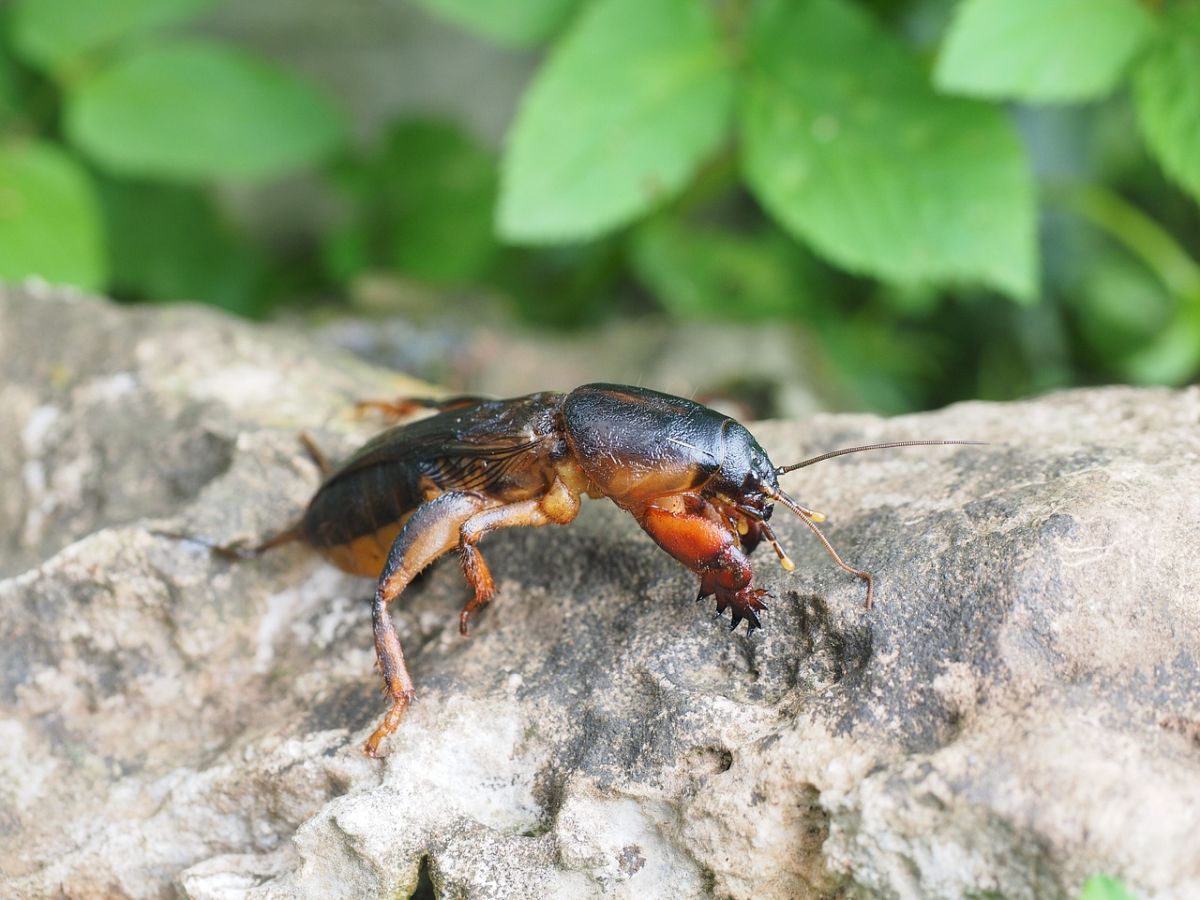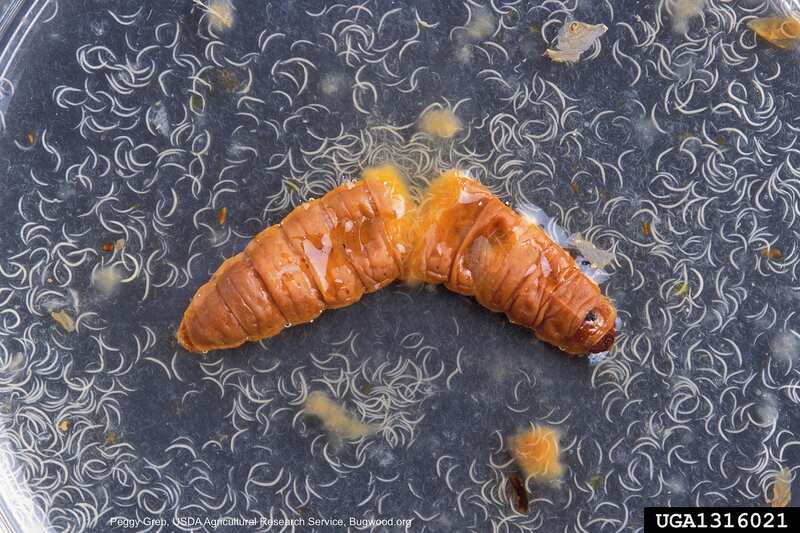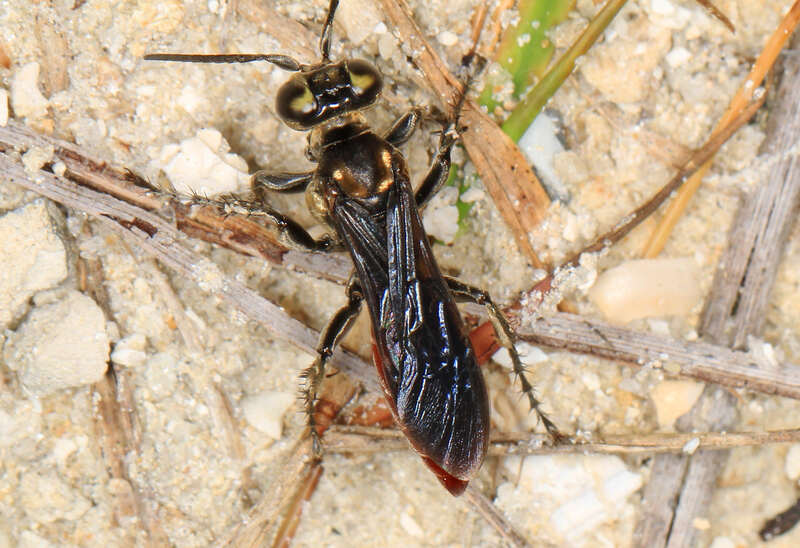
You can get rid of mole crickets chemically, using pesticides or baits, or with natural methods such as beneficial nematodes, neem oil, and good lawn care practices.
Mole crickets are strange-looking pests that burrow underground, feeding on the roots and blades of your grass. Without intervention, the damage can harm or kill parts of your lawn, so treatment timing is essential. With insights from an expert, we’ll explain the best ways to rescue your lawn from these determined pests.
Like their furry namesake, mole crickets have digging front legs and tunnel underground, creating small unsightly mounds of soil across your lawn. Because of the damage they cause to turfgrasses (especially warm-season grasses), those in the Neoscapteriscus genus are considered an insect pest in the Southeast. Let’s discuss how to get rid of them.
How to Get Rid of Mole Crickets With Pesticides

Insecticides
Both liquid and granular forms of insecticides are commercially available to control mole crickets. Purdue Professor of Entomology Douglas Richmond advises using caution and careful timing when using insecticides. He says, “Apply insecticides carefully if damage is above [an acceptable] threshold during vulnerable periods.”
But what (and when) is the vulnerable period for mole crickets? It’s the time when the crickets are still young and more susceptible to the effects of pesticides. “Treat when nymphs emerge (mid‑June to July), since they’re vulnerable then,” he says.
Mole crickets can build resistance to pesticides, so make sure to alternate products from different classes or use one that combines different classes of insecticides.
| Insecticide Classes | Active Ingredients |
| Organophosphates | Trichlorfon |
| Neonicotinoids | Imidacloprid or clothianidin |
| Synthetic pyrethroids | Permethrin, bifenthrin, lambda or gamma cyhalothrin, beta cyfluthrin, zeta cypermethrin |
Check the label for application instructions. If you don’t want to handle insecticides, leave the job to a pro. Contact one of our lawn care treatment experts today.
Baits
Mole cricket baits usually contain indoxacarb (from the oxadiazine class) or carbaryl (from the carbamate class of insecticides), and can be used in combination with the sprays or granules mentioned above. Spread the baits throughout your yard from late spring to early summer to kill the adult mole crickets that come out of the soil to feed.
Within a few days, you should notice a decrease in mole crickets as they consume the bait. To avoid the bait being washed away, ensure the forecast is clear of rain for a few days before spreading it.
Remember to follow the label’s instructions for precise and safe application.
How to Get Rid of Mole Crickets Naturally
Beneficial Nematodes

Microscopic worms that live in the soil, beneficial nematodes infect mole crickets and other lawn pests with a fatal bacteria. They do not harm beneficial insects (such as bees) and are considered safe for use around people and pets.
According to Richmond, while insecticides provide quicker results, nematodes can be an effective long-term solution: “Nematodes like Steinernema scapterisci, along with the parasitic wasps Larra bicolor, often outperform conventional pesticides in long-term mole cricket suppression.”
“But finding a commercial source for these natural enemies can be difficult,” he says. “In the Southern U.S., where mole crickets are more problematic, Steinernema scapterisci has been introduced and appears to be catching up to the most damaging mole cricket species.”
Besides Steinernema scapterisci, other species of beneficial nematodes used against mole crickets include Steinernema carpocapsae and Steinernema riobrave.
Natural Predators

Supporting natural enemies is another effective strategy against mole crickets, according to Richmond: “Parasitoid wasps (Larra bicolor), and native predators build consistent, natural suppression.”
Check the chart below to see how they hunt and how you can attract each of them.
| Natural Predator | How They Control Mole Crickets | How to Attract Them |
| Larra bicolor wasp | Deposit their eggs on mole crickets, eventually killing them | Plant these host plants: • Shrubby false buttonweed (Spermacoce verticillata) • Partridge pea (Chamaecrista fasciculata) • Star flower (Pentas lanceolata) |
| Ground beetles* | Hunt underground and/or on soil surface | Topdress lawn and beds with compost annually; encourage biodiversity |
| Assassin bugs** | Hunt underground | Use organic lawn care methods to encourage beneficial insects |
| Birds | Hunt close to the surface | Add birdbaths and native pollinator plants |
| Frogs | Hunt above the surface | Add a backyard pond |
* (Pheropsophus aequinoctialis and others from the Pasimachus genus)
** (Sirthenea genus)
Note: Armadillos are also natural predators of mole crickets, so if you see them on your lawn, it might indicate the presence of mole crickets in your turf.
Beneficial Fungi
Beneficial fungi such as Beauveria bassiana and Metarhizium spp. have also shown promise in controlling mole crickets. Marketed as types of biopesticides, these fungi kill mole crickets when incorporated or injected into the soil or applied as bait.
Neem Oil

Neem oil is a naturally occurring pesticide that you can spray on your lawn where you see mole cricket activity. A great method of organic pest control, neem oil not only kills mole crickets, but it also stops them from coming back again because of its repellent properties.
Apply neem oil at dusk or dawn to avoid harming foraging bumblebees. Neem oil can suffocate these beneficial insects, so it’s best to avoid peak buzzing hours.
Additional Ways to Control Mole Crickets Naturally
You can also hand-pick mole crickets early in the morning, or place sticky traps where you see signs of mole cricket activity. These methods may be helpful for very small mole cricket populations, but they are more often used as monitoring tools for larger outbreaks.
For Richmond, one of the best strategies to monitor mole crickets is to “regularly scout your lawn using the soap‐flush method.”
The soap-flush method consists of pouring soapy water on part of the suspected area to check if there are any mole crickets present:
- Mix 2 tablespoons of dish soap to 1 gallon of water.
- Pour the mix on 1 to 2 square feet of the affected area.
- Wait a few minutes for any underground mole crickets to rise to the surface.
How to Get Rid of Mole Crickets With Proper Lawn Care

Richmond explains that “a healthy turf is less attractive to mole crickets.” You just have to stick to the basics: “Maintain a healthy lawn by practicing proper mowing, irrigation, [and] fertilization,” he says.
Proper Mowing
Mole cricket control includes good lawn care practices to strengthen your turf. Mowing the right way is a good place to start: Mow at the recommended height for your grass type and with sharp mower blades to stimulate strong roots that can resist mole cricket damage.
It is also important to follow the one-third rule and never cut more than one-third of your grass height in a single mow, as this can weaken your turf.
Proper Watering
Water your lawn deeply, with 1 to 1.5 inches of water per week. You can do it by watering twice a week with 1/2 inch of water. Keep in mind that the soil must be moist 6 to 8 inches deep — that’s how you know you’ve watered deep enough.
Remember to adapt your watering schedule as the seasons change. See our guide on How to Water Your Lawn in Fall and Winter for more information.
Limit Outdoor Lighting During Mating Season
Mole crickets like bright outdoor light, so when you limit or eliminate outdoor lights, you’re lessening your chance of inviting mole crickets. It’s especially important to do so during their mating season, from March to early May, to prevent them from mating and laying eggs on your lawn.
Replace Highly Susceptible Grass Types
Certain warm-season grasses, such as bahiagrass, Bermudagrass, Zoysiagrass, and St. Augustinegrass, are more susceptible to mole cricket damage.
You can replace them with certain improved varieties that show better resistance to mole crickets, such as:
- Palisades, Cavalier, and Emerald varieties of Zoysiagrass
- TifSport hybrid bermudagrass
Mole crickets are also drawn to lawns with thatch build-up because it can harbor extra insects, which the southern mole cricket especially enjoys. So remember to dethatch your lawn regularly to avoid attracting these crickets.
FAQ About Mole Crickets
Mole crickets are attracted to moist, thatchy soils (especially in warm-season grasses like St. Augustinegrass, bahiagrass, and Bermudagrass). They are also attracted to bright outdoor lights.
No. Even though mole crickets are in the same family as crickets, they aren’t talented jumpers. Mole crickets burrow underground, creating tunnels and galleries as their method of transportation.
When you’re considering treatment for mole crickets, the best time to treat them is early summer (June or July), when the crickets are still immature.
When to Call a Professional
Mole crickets can be hard to manage yourself. To make this task easier, contact a lawn treatment pro to apply chemical or natural products or connect with a lawn care professional to dethatch your lawn, removing the excess thatch that mole crickets love.
Either way, with a little help, you can rest easy knowing your lawn is in the hands of a qualified pro (not a digging mole cricket).
Sources:
- “An Introduction to Ground Beetles: Beneficial Predators on Your Farm.” By entomology experts Matthew S. Jones, Joseph M. Taylor, and William E. Snyder. eOrganic.org.
- “Basic Biology of Mole Crickets.” University of Florida.
- “Biological Control of Mole Crickets by Fungal Pathogens.” University of Florida.
- “Biology and Control of Mole Crickets.” By David Held, associate professor, and Patricia Cobb, former extension specialist. Alabama A&M and Auburn Universities Extension.
- Douglas Richmond, turfgrass entomology Extension specialist and entomology professor at Purdue University, West Lafayette, IN. Personal interview.
- “Integrated Pest Management Control Strategies.” IFAS Extension.
- “Mole Cricket Management in Turfgrass.” By Gary Forrester, horticulture extension agent, and Joey Williamson, HGIC horticulture extension agent. Clemson University.
- “Mole Crickets.” University of Florida, Institute of Food and Agricultural Sciences.
- “PMU Focus: Mole Crickets—A Classical Exotic Pest.” By Adam Dale, entomology expert. IFAS Extension.
- “Population Regulation of Mole Crickets by Natural Enemies.” University of Florida.
Main Photo Credit: Pixabay